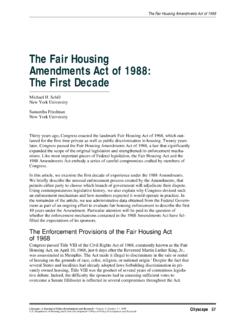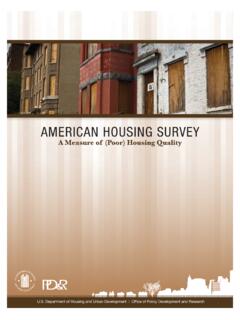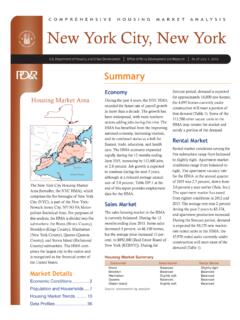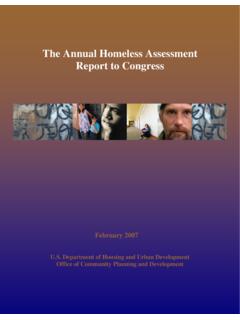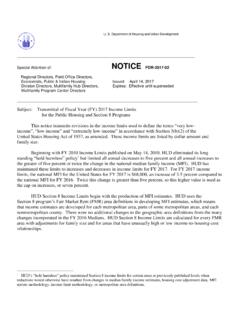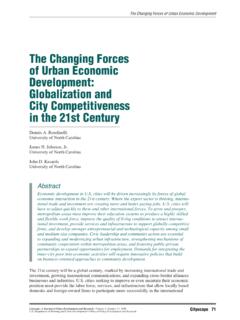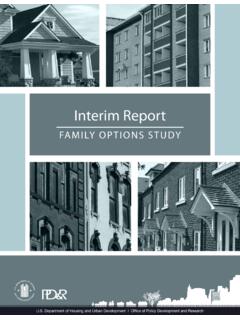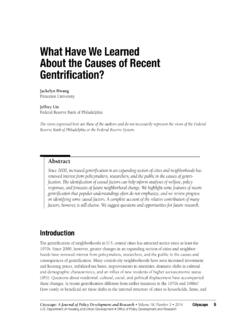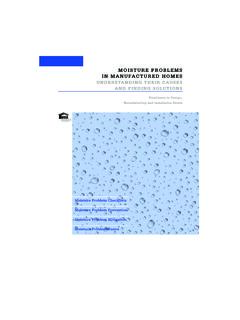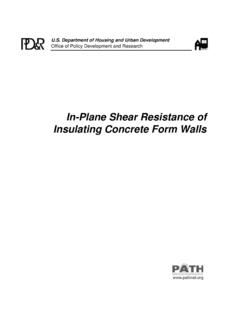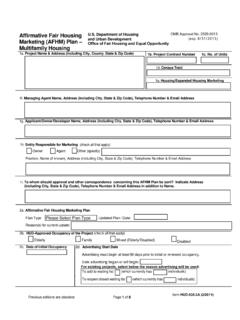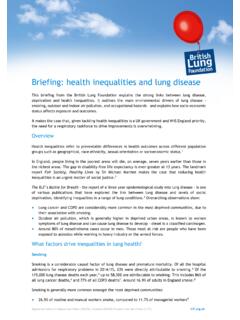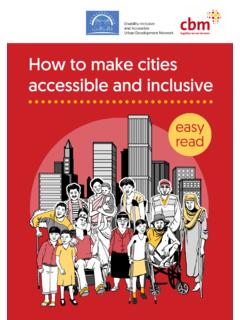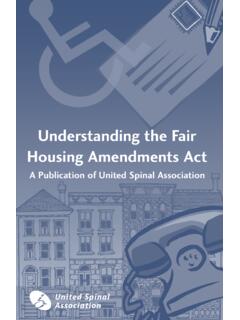Transcription of Accessible and Usable Public and Common Use Areas
1 Chapter Two: REQUIREMENT 2 Accessible and Usable Public and Common Use Areas ..covered multifamily dwellings with a building entrance on an Accessible route shall be designed in such a manner that the Public and Common use Areas are readily Accessible to and Usable by handicapped persons. fair housing Act Regulations, 24 CFR 2 PART TWO: CHAPTER 2 fair housing ACT DESIGN MANUAL Definitions from the Guidelines Accessible . When used with respect to the Public and Common use Areas of a building containing covered multifamily dwellings, means that the Public or Common use Areas of the building can be approached, entered, and used by individuals with physical handicaps.
2 The phrase readily Accessible to and Usable by is synonymous with Accessible . A Public or Common use area that complies with the appropriate requirements of ANSI 1986, a comparable standard or these guidelines is Accessible within the meaning of this paragraph. Common Use Areas . Rooms, spaces, or elements inside or outside of a building that are made available for the use of residents of a building or the guests thereof. These Areas include hallways, lounges, lobbies, laundry rooms, refuse rooms, mail rooms, recreational Areas , and passageways among and between buildings. Public Use Areas . Interior or exterior rooms or spaces of a building that are made available to the general Public .
3 Public use may be provided at a building that is privately or publicly owned. Accessible AND Usable Public AND Common USE SPACES INTRODUCTION The fair housing Accessibility Guidelines (the Guidelines) require Public and Common use Areas and facilities in covered multifamily housing developments to be Accessible to people with disabilities so they may benefit from and enjoy the amenities present in the housing development in which they live. Public and Common use Areas that must be Accessible include, but are not limited to, such spaces and elements as selected on-site walks, parking, corridors, lobbies, drinking foun tains and water coolers, swimming pool decks or aprons, playgrounds, rental offices, mailbox Areas , trash rooms/refuse disposal Areas , lounges, club houses, tennis courts, health spas, game rooms, toilet rooms and bathing facilities, laundries, com munity rooms, and portions of Common use tenant storage.
4 The Guidelines require an Accessible route (see page ) to Public and Common use spaces, but not all features or elements within that space may be required to be Accessible . The scoping provisions, or where, when, and how many elements and spaces must be Accessible , will be addressed throughout this chapter. For example, where multiple recreational facilities are provided, the Guidelines do not require that each amenity be Accessible , but rather that sufficient numbers be Accessible to provide equitable use by people with disabilities. In general, however, if each building on a site has its own trash room, lounge area, laundry room, game room, etc.
5 , then each of these in each building must be on an Accessible route and comply with the applicable portions of an appro priate accessibility standard since they serve different buildings. For an overview of the scoping requirements refer to the illustrations on pages through and to the chart, taken from the Guidelines, entitled Basic Components for Accessible and Usable Public and Common Use Areas or Facilities, reprinted on the next page. Accessible AND Usable Public AND Common USE SPACES SCOPE OF ANSI AND THE ADA IN Public AND Common USE SPACES APPLICATION OF ANSI - 1986 The fair housing Act references the ANSI Standard (American National Standard for Buildings and Facilities: Providing Accessibility and Usability for Physically Handicapped people ) as an acceptable means of complying with the design requirements of the Act.
6 However, the Act does not exclusively require following ANSI The fair housing Act regulations of the Department of housing and Urban Development (HUD) adopt the ANSI Standard, but specify the 1986 version of the ANSI Standard. Likewise, the Guidelines refer ence specific portions of the 1986 ANSI Standard. The Guidelines are to provide technical guidance and are not mandatory. They provide a safe harbor for compliance with the accessibility requirements of the Act. The Purpose section in the Guidelines states that Builders and developers may choose to depart from these guidelines and seek alternate ways to demonstrate that they have met the requirements of the fair housing Act.
7 If an accessibility standard other than the ANSI Standard is followed, care must be taken to ensure the standard used is at least equivalent to or stricter than the 1986 ANSI Standard. See also the ANSI Standard discussion in the Introduction on page 13. The Guidelines, in some instances, modify the ANSI specifications and, in other instances, substitute specifications. The illustrations in this chapter provide an overview of many of the key requirements for Public and Common use Areas . When designing these Areas it is essential to refer to the 1986 ANSI Standard specifications through , as appropriate (or an equivalent or stricter standard), for detailed dimensional design specifications for each required Accessible element or space.
8 Note: When this Manual states the ANSI Standard or the ANSI Standard must be followed it means the 1986 ANSI Stan dard or an equivalent or stricter standard. ANSI Technical Specifications for Accessible Elements and Spaces Basic Space Allowances and Reach Ranges Accessible Route Protruding Objects Ground and Floor Surfaces Parking Spaces and Passenger Loading Curb Elevators Platform Lifts Windows Drinking Fountains and Water Coolers Water Closets Toilet Stalls Lavatories, Sinks, and Mirrors Shower Stalls Toilet Rooms, Bathrooms, Bathing Facilities, and Shower Rooms Grab Bars, and Tub and Shower Seats Controls and Operating Mechanisms Detectable Warnings Telephones Seating, Tables.
9 And Work Surfaces Auditorium and Assembly Areas PART TWO: CHAPTER 2 Public AND Common USE Areas NOT COVERED BY THE GUIDELINES Where a newly constructed development consists entirely of buildings of four or more multistory dwelling units without elevators ( , two-story townhouses), the development is not required to comply with the fair housing Act or the Guide lines. Since there are no covered multifamily dwellings on the site, no Public and Common use Areas anywhere on the site are required to be Accessible . Note, however, that the Americans with Disabilities Act (ADA) of 1990 may apply. See the discussion of the ADA in the next column. However, in housing developments of two-or three-story walk-up buildings where the ground floor dwelling units are single-story, all the ground floor units are covered (unless site impracticality can be claimed, see Chapter 1: Accessible Building Entrance on an Accessible Route ) and must be on an Accessible route with Accessible entrances.
10 Since an Accessible route does not go to the upper floors, then the stairs up to those dwelling units, and the halls, corridors, and entry doors on the upper floors are not covered by the requirements of the Guidelines. Of course, Public and Common use facili ties must be Accessible and cannot be located on upper floors of buildings which do not have an elevator(s), unless similar facilities also are located on the ground floor. For example, it would not be acceptable to have a Common use trash room on the second floor of a building and not have one on the ground floor of the same building. fair housing ACT DESIGN MANUAL IMPACT OF THE AMERICANS WITH DISABILITIES ACT (ADA) ON Public AND Common USE SPACES The dwelling units of private multifamily housing developments generally are not required to meet the accessibility provisions of the Americans with Disabilities Act Accessibility Guidelines (ADAAG).
